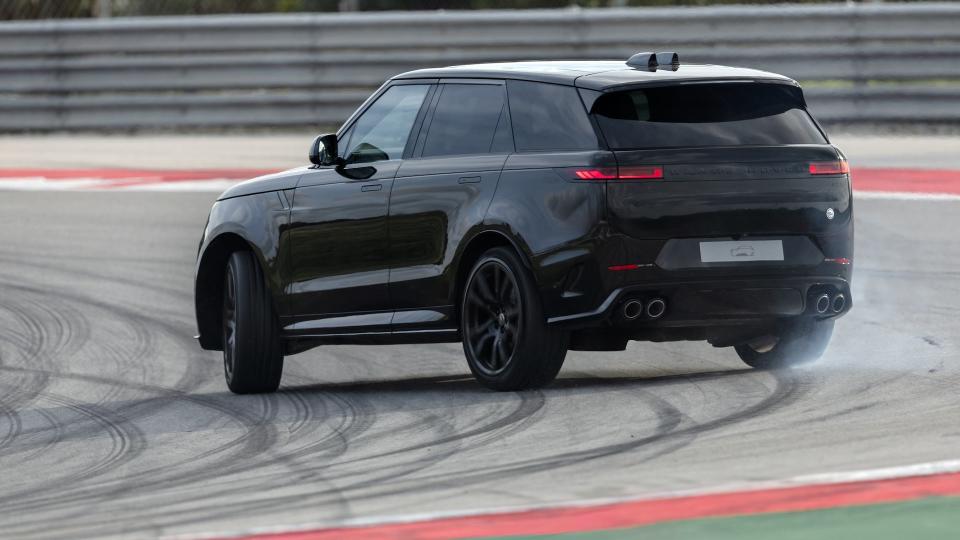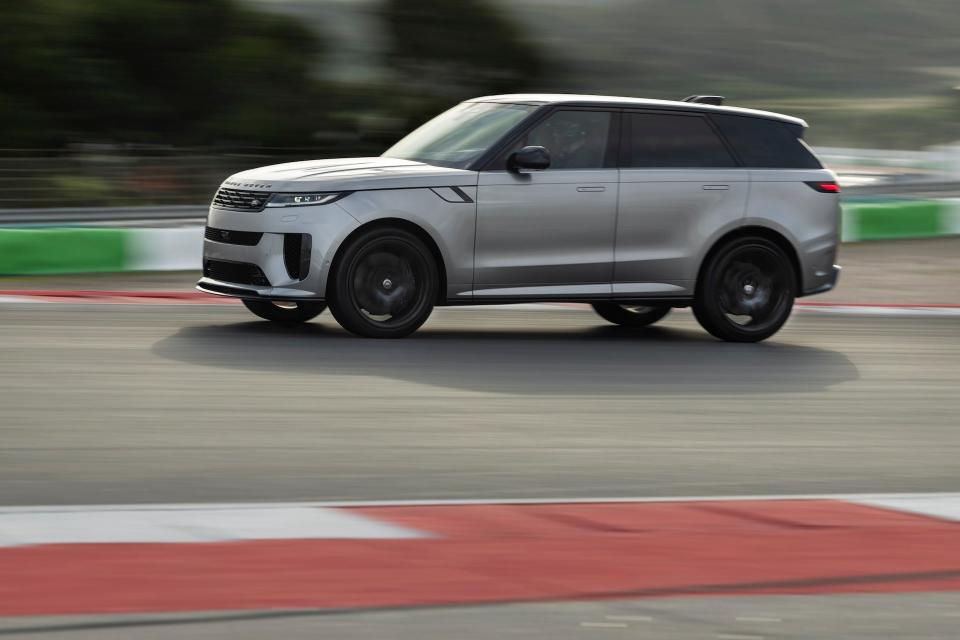How the Range Rover Sport SV’s Brakes Survived 215 Laps Around an F1 Track

It doesn't matter how hard you try, you can't escape the laws of physics. And even if you sucked at physics class like I did, I can understand one of the more basic principles: more weight equals more friction, and more friction equals more wear and tear. In car speak, a heavy car will erode its brakes quicker than a lighter car. So, you can understand my reaction when I heard that the 2024 Range Rover Sport SV survived hundreds of miles of punishing track duty on a single set of brake pads.
Allow me to paint a picture of the Range Rover Sport SV. With 626 horsepower, it's the rowdiest Range Rover money can buy. Obviously super luxurious and equipped with every tech and comfort feature imaginable, it's also a serious off-roader worthy of its badge. And at nearly 5,500 pounds, it's a big and heavy mothertrucker.

The British marque held the global media drive for the Sport SV in Portugal's Autódromo Internacional do Algarve. As the host of MotoGP and even Formula 1 in 2020 and 2021, the 2.85-mile circuit is properly fast and challenging. A GP bike will hit 214 mph at the end of the main straight, while Esteban Ocon's Alpine reached 206 mph in 2021. More than half of its corners are blind, and I'd say nearly every one of them sits at different elevations. Driving it at speed is physically and mentally challenging.
Track Time
With me at the wheel of the go-fast Range Rover, the speedo would flash 150 mph before having to stand firmly on the brakes. After shaving off about 90 mph in a matter of two to three seconds, I'd take the first right-hander at around 70 mph and follow the outside line as it drastically tightens toward Turn 3, a 90-degree right turn taken at about 40 mph.
The first stab at the brake pedal was much softer than one might expect from a big-braked performance vehicle slowing down from 150 mph. That relative softness allowed for excellent modulation of the braking force, which was necessary to nail Algarve's first three apexes.
There are still another 12 corners to deal with at that point; several of them involving braking from around 100 mph while going downhill. These downhill braking events felt even more violent than the others at higher speeds, sensations which were confirmed by data pulled from the cars later on. The brake pedal remained consistent and reassuring at every corner and every lap, which is exactly what you want while slinging a $180,000 beast around an F1 track.
https://www.youtube.com/watch?v=P-KBCsVK5eo
That's a lot of braking for a 5,478-pound SUV. Do this multiple times a day over a week in relatively warm weather, and you're definitely gonna cook some brakes.
After the event, a JLR staffer shared that the track team didn't tap into the spare brake pads brought for the test fleet. As one of probably a hundred journalists who put in a few laps on the track and abused the hell out of the brakes, this caught my attention. He was surprised, I was surprised, and frankly, I thought it was a mistake.
After following up on the claim and exchanging a few emails, JLR connected with Hugo Mazzoleni, the brakes team lead for the Sport SV program. As it turns out, it wasn't a mistake, and the data taken from the cars that lapped the Algarve circuit was even more revealing.
Before I explain how this was possible, here's the data JLR provided: each test car started out with roughly 1,000 miles on the odometer, meaning that every component including the brakes had already been broken in. On average, each vehicle covered 215 laps around the track, which translates into 615 track-only miles. According to the data, the downhill approach into the Turn 5 hairpin generated the most friction, measured at 1.1 g.
In their report, the Range Rover folks told The Drive that they didn't need to change brake pads or rotors. In fact, "the brake pads for the Carbon Ceramic Braking system still have around 30% of their usable life left (before the brake pad wear indicator will be triggered)."



As someone who gets the chance to drive modern, heavy cars on the track a few times a year—and has a crumb of racing experience—I found that pretty impressive. Of course, I wanted to know how that was possible. What exactly is to blame (or thank) for said brake efficiency?
The Solution
Let's start with the Brembo Octyma front brake calipers; Octyma plays with the Latin word "Octo," meaning that—you guessed it—each caliper has eight pistons. Developed specifically for the Range Rover Sport SV, Brembo says these are the world's first calipers with a cross-shape piston arrangement. This unique layout reportedly allows the caliper to distribute even pressure along the pad while it's being pushed against the rotor.
"The cross-shape piston arrangement maximizes braking efficiency with improved pressure distribution and more uniform brake pad wear," Mazzoleni told The Drive. "The unique eight-piston front calipers—the largest ever fitted to a Range Rover—is the biggest contributor to this exceptional wear performance."


And just wait until you hear the marketing line for the brake rotors: "Sport SV features the largest brake discs available in the automotive industry, and the largest brake pads on any JLR vehicle to date."
It's true. At 17.3 inches up front and 15.3 inches in the back, it edges out the Lamborghini Urus rotors by 0.8 inches. JLR explained that the carbon ceramic rotors cool much faster than typical iron rotors, directly impacting brake pad temperatures. In addition to revised styling and cooling ducts, this explains why I never experienced brake fade while lapping the Algarve—and neither did anyone else.
"On track, around 2x reduction in pad wear and up to 10x reduction in disc wear," added Mazzoleni.
Lastly, the 626-horsepower SV wears a bespoke brake pad compound, which according to Range Rover, was chosen for its resistance to fade at higher temperatures. So whether you're tearing up a track in Portugal or a sand dune in the Middle East, the pad's internal temperature can be managed to assist in longevity.


According to Brembo, the entire braking system is also mighty efficient, weighing 74.9 pounds less than a comparable cast iron unit. It's a similar story with the optional 23-inch carbon wheels on my tester, which weighed 73 pounds less than the same-size alloy wheels. That's a massive reduction in unsprung weight.
As it turns out, it's not just one thing, is it? It's a mighty braking system with cutting-edge tech from JLR and Brembo, critical cooling tweaks, lightweight materials, and a complex suspension without anti-roll bars that keep the body as stable as possible under braking.
You may not escape the laws of physics, but you can sure throw everything and the kitchen sink at them to try and lessen their impact. That's what the folks at JLR have done with the 2024 Range Rover Sport SV.
2024 Range Rover Sport SV Edition One Specs | |
|---|---|
Email the author at jerry@thedrive.com

 Yahoo Autos
Yahoo Autos 